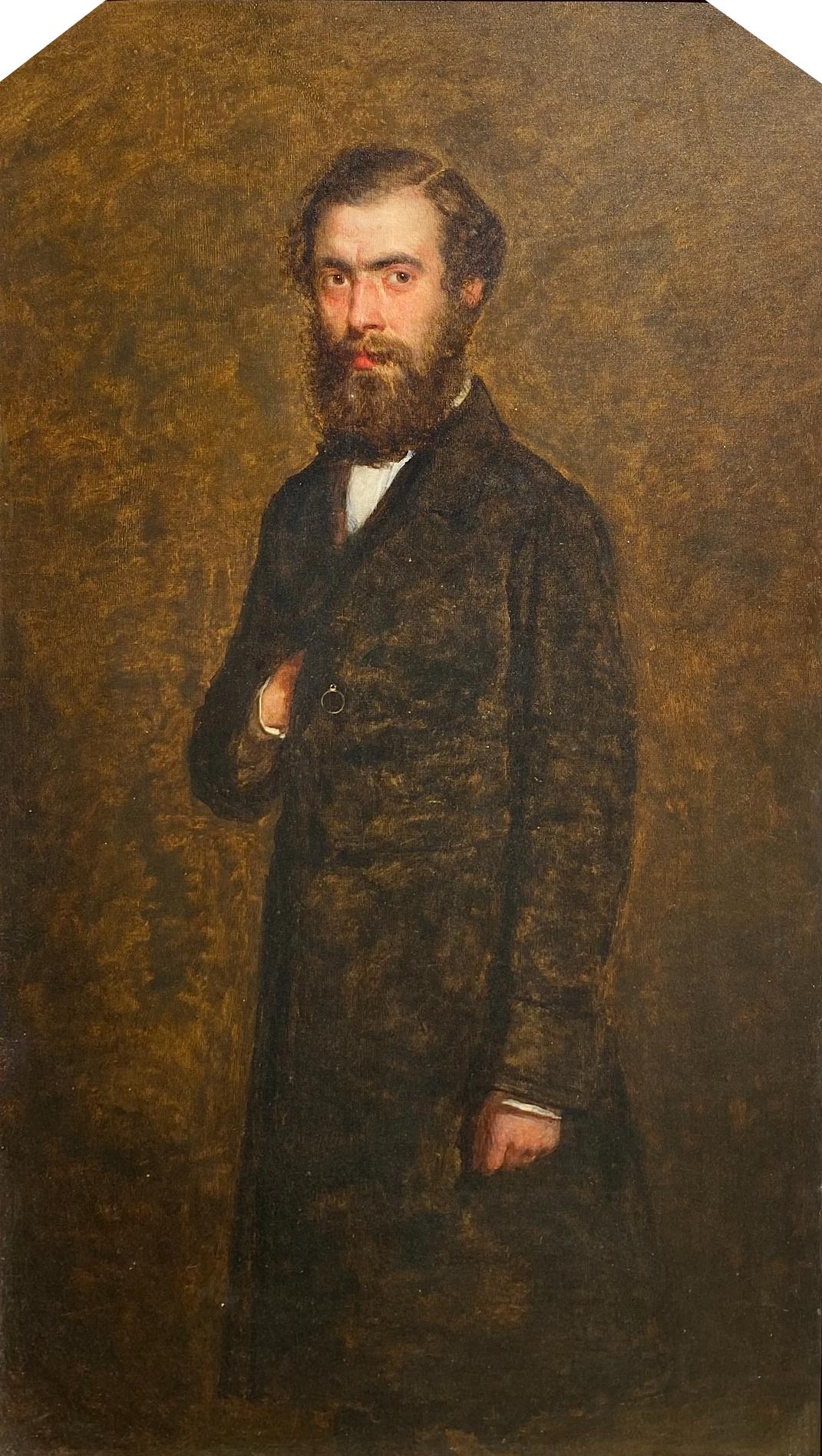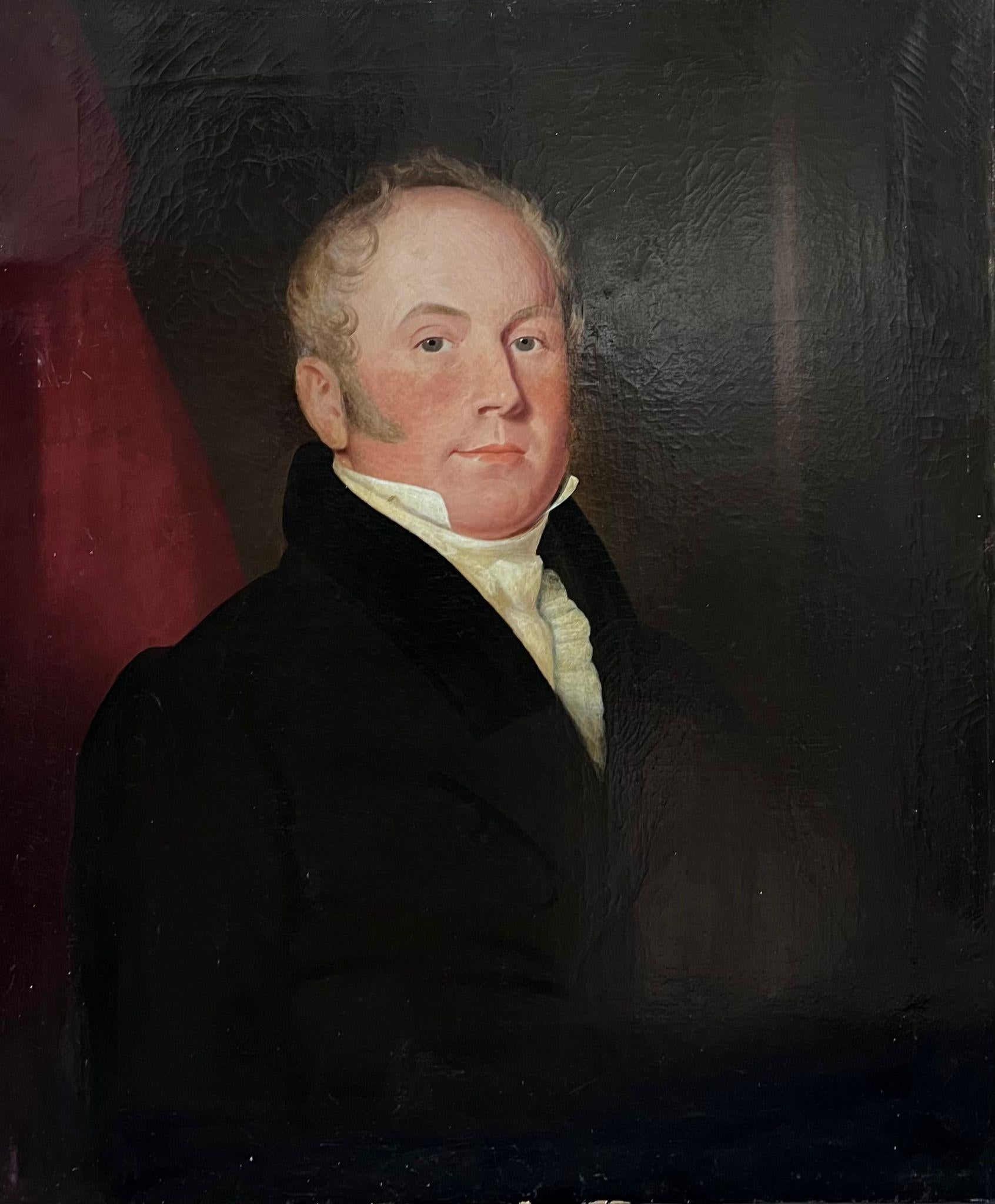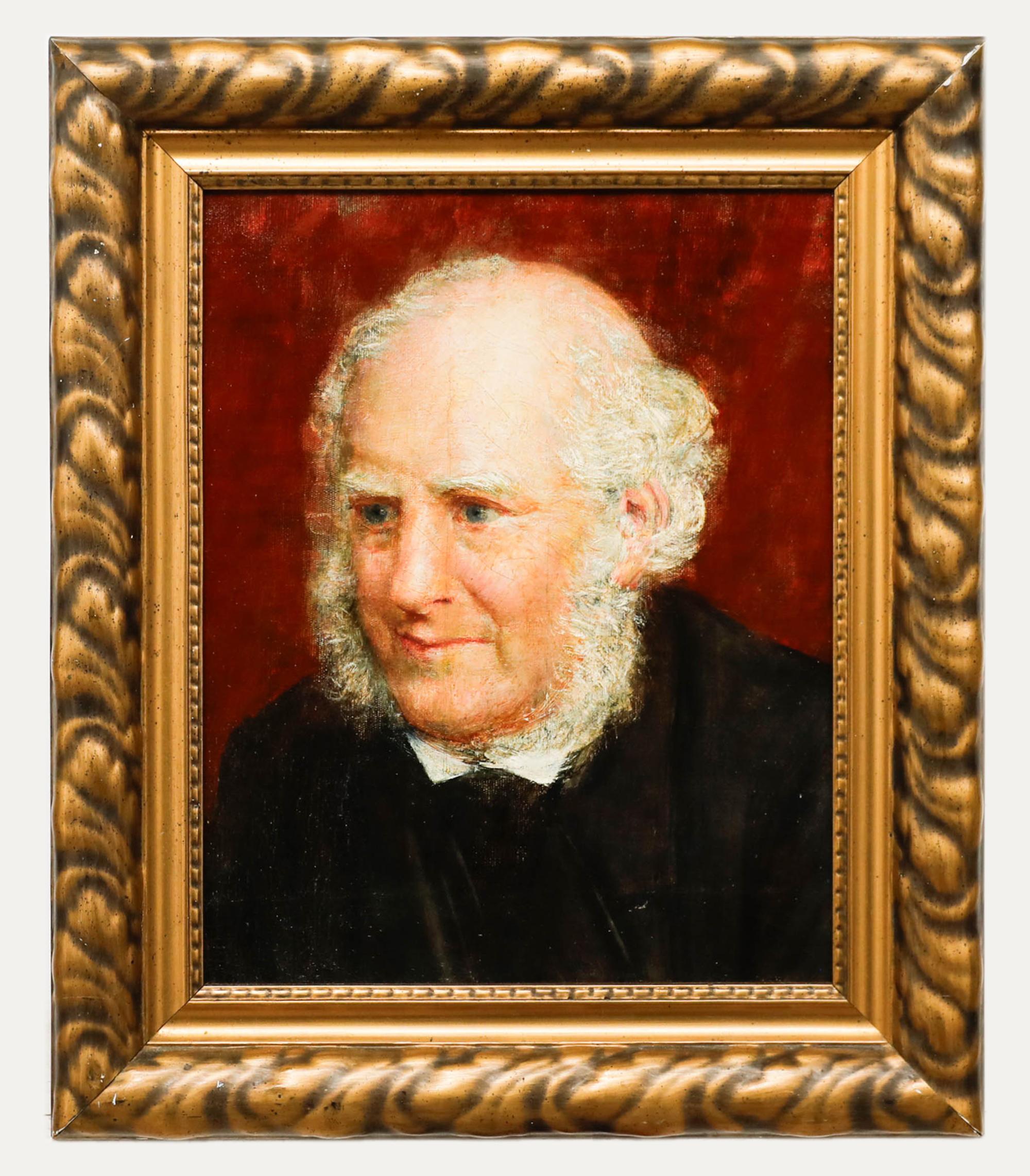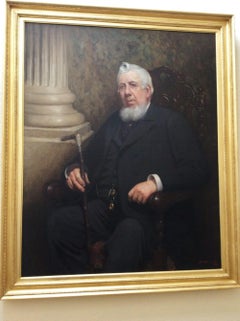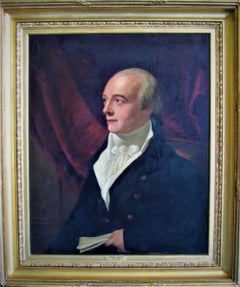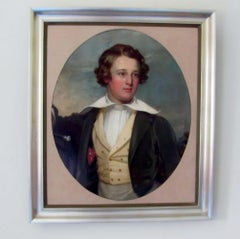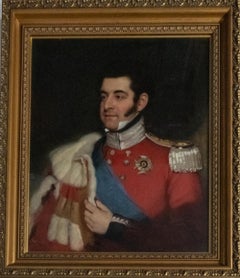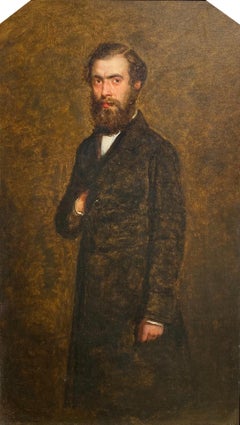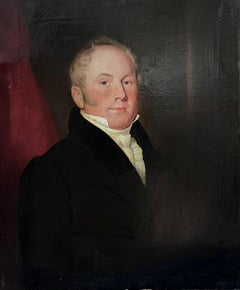Items Similar to 19th century portrait , oil on canvas , Baddesley Clinton, by R Dering
Want more images or videos?
Request additional images or videos from the seller
1 of 8
Rebecca Dering19th century portrait , oil on canvas , Baddesley Clinton, by R Dering19th century
19th century
$5,504
£3,995
€4,665.39
CA$7,620.67
A$8,319.95
CHF 4,361.81
MX$101,048.94
NOK 54,471.87
SEK 51,435.97
DKK 34,822.13
About the Item
19th century, oil, Baddesley Clinton THE PHILOSOPHERS MORNING WALK R Dering
Here is a fine painting of Edward H Derring of Baddesley Clinton , a national trust property near solihull
This portrait shows Edward Dering holding a copy of the writings of St Thomas Aquinas, as he was studying Catholic philosophy. Baddesley Clinton, with the new wing, can be seen in the background. He is wearing the old fashioned dress, which he favoured.
inscribed 'Edward .H. Dering' (upper left); signed, inscribed and dated 'THE PHILOSOPHERS MORNING WALK/BADDESLEY CLINTON/R.DERING.PINXIT./1894' (lower left)
oil on canvas, housed on a gilt frame, the size is 117.5 x 81.5cm (46 1/4 x 32 1/16in whilst overall the framed size is 130 x 94cm
The present work is a version of The Philosopher's Morning Walk currently in the Baddesley Clinton Collection, Warwickshire. See Photo for painting in situ
Dering was an artist in oils and watercolours with many of her works at Baddesley
Both painting and frame are in good condition, the painting having had some restoration especially to the clouds upper left. The frame one or two minor losses which have been re gilded.
There is an interesting story behind the artist and sitter, which as an ex guide of Baddesley, i have spent many an afternoon recounting the story . Brief version below
The subject of the painting, Edward Heneage Dering, married the artist in 1885 after a misconstrued marriage proposal in 1859 which led to his first marriage to Rebecca's guardian, Lady Chatterton. Rebecca married Edward Dering's closest friend, Marmion Edward Ferrers and both couples lived at Baddesley Clinton, Ferrers' family home. Lady Chatterton died in 1876 and Ferrers in 1884, at which point Rebecca and Edward were free to marry as they had originally intended. Edward Dering died in 1892.
Baddesley Clinton is a moated manor house, about 8 miles (13 km) north-west of the town of Warwick, in the village of Baddesley Clinton, Warwickshire, England. The house probably originated in the 13th century, when large areas of the Forest of Arden were cleared for farmland. The site is a Scheduled Ancient Monument[1] and the house is a Grade I listed building.[2] The house, park and gardens are owned by the National Trust and open to the public
Rebecca Dulcibella Orpen (1830?-1923)
Rebecca Dulcibella Orpen (1830?-1923) was a 19th-century artist. As she married twice, she is occasionally referred to as Rebecca Dulcibella Orpen Ferrers, Mrs Edward Henege Dering, or Rebecca Dering.
Rebecca Dulcibella Orpen was born either in 1829 or 1830, the historical record is murky as to which, in County Cork, Ireland. She was the daughter of Abraham Edward Orpen and Martha Chatterton She appears to have spent much of her youth with her aunt, Lady Georgiana Chatterton and her husband, Sir William Chatterton, and may have eventually gone to live with them
In 1859, Lady Georgiana married Edward Heneage Dering. It has been suggested that Dering was actually intending to propose to Rebecca but, as a result of a misunderstanding, came to be engaged to Lady Georgiana, who was much older than him. However, that story does not appear to have strong historical substantiation. After the pair wed, Orpen and the couple travelled Europe, sketching and drawing as they went. A great many pieces Rebecca produced during this time are held by the National Trust.
At the age of 37, on 18 July 1867, Rebecca Dulcibella Orpen married Marmion Edward Ferrers of Baddesley Clinton. Two years later, Lady Georgiana and her husband, Edward Heneage Dering, moved in with Rebecca and Marmion at Baddesley Clinton. The foursome, who became known as The Quartet, immersed themselves in the arts and in the restoration of Baddesley Clinton. Their other interests also included novel-writing, music, poetry, and embroidery.
The Quartet were also Catholics, a not-uncommon feature of Baddesley Clinton. The Ferrers family that held the estate had historically been Catholics, and the estate had even been used to shelter Catholics when their presence in England was not legal. The diary of John Henry Newman suggests that Edward Dering, Lady Georgiana, and Rebecca Orpen were received into the Church of Rome in 1865. The Quartet were responsible for the addition of a chapel to the house's first floor, Rebecca providing paintings for it. (In the 1940s, Undine Ferrers, the wife of a distant relative of Marmion, ripped out the shrubbery had added the house, apparently feeling that the dark foliage represented "the dark forces of Catholicism."
The Great Hall, Baddesley Clinton, with Mr and Mrs Marmion Ferrers, Edward Heneage Dering and Lady Chatterton (Mrs Dering) by Rebecca Dulcibella Orpen (1870)
After the foursome had lived together for seven years, Lady Georgiana passed away in 1876 She left Rebecca money in trust. In 1884, Marmion died as well. He left his wife everything that he owned, including the tenancy on Baddesley Clinton until she died. Rebecca Orpen and Edward Dering, the surviving members of the foursome, remained together at Baddesley Clinton; however, because it was not socially acceptable for an unmarried man and woman to live together alone, a local priest came to stay with them for 13 months. 21 September 1885, the two surviving members of the Quartet married
- Creator:Rebecca Dering (English)
- Creation Year:19th century
- Dimensions:Height: 51.19 in (130 cm)Width: 37.01 in (94 cm)
- Medium:
- Movement & Style:
- Period:
- Condition:
- Gallery Location:York, GB
- Reference Number:1stDibs: LU1800215482622
About the Seller
5.0
Vetted Professional Seller
Every seller passes strict standards for authenticity and reliability
Established in 1991
1stDibs seller since 2022
24 sales on 1stDibs
Typical response time: 15 hours
- ShippingRetrieving quote...Shipping from: York, United Kingdom
- Return Policy
Authenticity Guarantee
In the unlikely event there’s an issue with an item’s authenticity, contact us within 1 year for a full refund. DetailsMoney-Back Guarantee
If your item is not as described, is damaged in transit, or does not arrive, contact us within 7 days for a full refund. Details24-Hour Cancellation
You have a 24-hour grace period in which to reconsider your purchase, with no questions asked.Vetted Professional Sellers
Our world-class sellers must adhere to strict standards for service and quality, maintaining the integrity of our listings.Price-Match Guarantee
If you find that a seller listed the same item for a lower price elsewhere, we’ll match it.Trusted Global Delivery
Our best-in-class carrier network provides specialized shipping options worldwide, including custom delivery.More From This Seller
View AllPortrait Of A Gentleman George Williams Kenworthy by John Dalziel Kenworthy
Located in York, GB
John Dalziel Kenworthy portrait of a gentleman . Fine, large and imposing oil on canvas housed in a gilt frame.
The sitter is unidentified, he has an aristocratic and characterful lo...
Category
Early 1900s Old Masters Portrait Paintings
Materials
Oil
19th century Portrait Spencer Perceval Attributed To George Francis joseph
By George Francis Joseph
Located in York, GB
A late 18th early 19th century oil on canvas Portrait of Prime Minister Spencer Perceval, bust-length, in an interior, holding papers.Attributed to George Francis Joseph...
Category
19th Century Old Masters Portrait Paintings
Materials
Oil
19th century Portrait Of A Young Man, Oil, Circle Of Thomas Jones Barker
Located in York, GB
Portrait of a young man,
half length wearing a yellow waistcoat and holding a cane , Circle of Thomas Jones Barker (1815-1882),(unsigned)
Oil on canvas, h...
Category
19th Century Realist Portrait Paintings
Materials
Oil
19th century portrait military officer 5th Royal Lancashire Militia, East Lancs
Located in York, GB
A fine 19th century oil on canvas portrait stated to be Captain Paul John Henry Butler, 5th Royal Lancashire Militia, half length, wearing breast star. Hou...
Category
19th Century Realist Portrait Paintings
Materials
Oil
19th century Portrait of a lady, Priscilla Osborn, William Jacob Baer
Located in York, GB
PORTRAIT OF PRISCILLA, MRS WILLIAM OSBORN half length, oil on canvas,
WILLIAM JACOB BAER (1860-1941) housed in the original early 19th c gilt cavetto frame
The overall size being 94....
Category
19th Century Old Masters Portrait Paintings
Materials
Oil
$3,301 Sale Price
20% Off
Free Shipping
19th century Portrait of a Lady, Attributed to Sir Frank Dicksee
Located in York, GB
Portrait of a very attractive Lady, head-and-shoulders in length
monogrammed FD, inscribed to verso, oil on canvas, 50cm x 40cm
whilst overall is 59 x 69 cm .
In overall good condition some craquelure. Has been relined and cleaned.
original frame some minor losses (self coloured)
Frank...
Category
19th Century Old Masters Portrait Paintings
Materials
Oil
$3,168 Sale Price
34% Off
Free Shipping
You May Also Like
Portrait of William Cooper - British Victorian art male portrait oil painting
By Thomas Lawrence
Located in Hagley, England
This superb Victorian portrait oil painting is attributed to circle of Thomas Lawrence. Painted circa 1836 the sitter is William Henry Cooper, of Pains Hill, Cobham, Surrey and Hig...
Category
1830s Victorian Portrait Paintings
Materials
Oil
$9,368 Sale Price
20% Off
Portrait of G W Barber JP - British Victorian exhibited art oil painting
Located in Hagley, England
This superb British Victorian exhibited portrait oil painting is by noted female artist (Frances) Maud Porter. Her married name was Maud Bigwood and some of her later work is signed ...
Category
1890s Victorian Portrait Paintings
Materials
Oil
$4,408 Sale Price
20% Off
Portrait of Doctor Carter, Scottish 19th Century Signed Oil Painting
Located in London, GB
Oil on board, signed, titled and dated '1858' on verso
Image size: 10 1/2 x 18 1/2 inches (26.5 x 47 cm)
Gilt frame
This is a wonderful portrait that was painted by John Burr at a t...
Category
Late 19th Century Portrait Paintings
Materials
Oil, Board
19th Century English Victorian Oil Painting on Canvas Portrait of a Gentleman
Located in Cirencester, Gloucestershire
Portrait of an English Gentleman
English artist, 19th century
oil on canvas, unframed
Canvas: 30.5 x 25 inches
Provenance: Private collection, England
Condition: overall very good an...
Category
19th Century Victorian Portrait Paintings
Materials
Oil, Canvas
Arthur Trevor Haddon (1864-1941) - 19th Century Oil, Portrait of a Man
By Arthur Trevor Haddon
Located in Corsham, GB
This portrait depicts an elderly gentleman with white hair and a beard, gazing thoughtfully to the side against a rich, dark background. The ornate gold frame surrounding the paintin...
Category
19th Century Portrait Paintings
Materials
Oil
Portrait of a Gentleman - British Edwardian art male portrait oil painting
Located in Hagley, England
This lovely British Edwardian Impressionist portrait oil painting is by noted artist Percy William Gibbs. Pained circa 1910 it is a head and shoulders portrait of a gentleman in a da...
Category
1910s Impressionist Portrait Paintings
Materials
Oil
More Ways To Browse
Pair Of 19th Century Oil Portraits
Pair 19th Century Oil Portrait Paintings
19th Century Irish Oil Paintings Portraits
Emile Othon Friesz
Figurative Neoclassical Paintings
Francoise Nielly
Harris Marcus
Hyper Realist Art
Mexican Girl
Oil Paintings Arab
Painting Of A Clown
Painting Pirate
Paintings By Ernesto
Pietro Ruffo
Rizaldy Celi Jr
Robert Michel
Swim Cap
Vintage Brubaker


